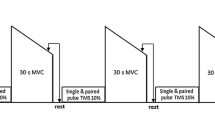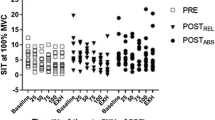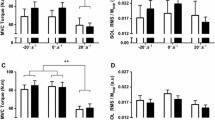Abstract
Purpose
To examine corticospinal excitability and neuromuscular function following the completion of eccentric (ECC) or concentric (CON) maximal exercises of same mechanical work.
Methods
Ten males (29.9 ± 11.8 years) performed maximal isokinetic knee extensor contractions in four experimental sessions. The two first sessions (one in ECC and one in CON) ended with a dynamic peak torque loss of 20%. The work completed in each contraction type was then achieved in the other contraction type. Neuromuscular function- maximal voluntary isometric contraction (MVIC), voluntary activation level (VAL), potentiated doublet (Dt), M-wave- and corticospinal excitability- motor evoked potential (MEP) amplitude and silent period (SP)—were assessed in the vastus lateralis (VL) and rectus femoris (RF) muscles at 20% MVIC before and immediately after exercise.
Results
To lose 20% of dynamic peak torque subjects performed 1.8 times more work in ECC than CON (P = 0.03), inducing a non-different decline in MVIC (P = 0.15). VAL dropped after the ECC sessions only (− 8.5 ± 6.7%; all P < 0.027). Only, the CON session featuring the greatest work affected Dt amplitude (− 9.4 ± 23.8%; P = 0.047). In both muscles, MEP amplitude decreased (all P < 0.001) and MEP SP stayed constant (all P > 0.45), irrespective of contraction type (all P > 0.15).
Conclusion
Same-work maximal ECC and CON exercises induced similar fatigue level but from different origins (preferentially central for ECC vs peripheral for CON). Yet, net corticospinal excitability did not depend on contraction type.





Similar content being viewed by others
Change history
17 February 2021
A Correction to this paper has been published: https://doi.org/10.1007/s00421-020-04578-0
Abbreviations
- ANOVA:
-
Analysis of variance
- CON:
-
Concentric
- CONF:
-
Concentric session aiming for 20% MVIC loss
- CONW:
-
Concentric session aiming for the work completed in ECCF
- Dt:
-
Double twitch
- Dtsup:
-
Superimposed double twitch
- ECC:
-
Eccentric
- ECCF:
-
Eccentric session aiming for 20% MVIC loss
- ECCW:
-
Eccentric session aiming for the work completed in CONF
- EMG:
-
Electromyography
- MVIC:
-
Maximal voluntary isometric contraction
- MVICstim:
-
Maximal voluntary isometric contraction when stimulated
- MMAX :
-
Maximal M-wave
- RF:
-
Rectus femoris
- RMS:
-
Root mean square
- SP:
-
Silent period
- TMS:
-
Transcranial magnetic stimulation
- VAL:
-
Voluntary activation level
- VL:
-
Vastus lateralis
- SENIAM:
-
Surface ElectroMyoGraphy for the Non-Invasive Assessment of Muscles
References
Aagaard P, Simonsen E, Andersen J, Magnusson S, Halkjær-Kristensen J, Dyhre-Poulsen P (1998) Neural inhibition during eccentric and concentric quadriceps contraction: effects of resistance training. Med Sci Sports Exerc 30:207
Abbott BC, Bigland B, Ritchie JM (1952) The physiological cost of negative work. J Physiol 117:380–390. https://doi.org/10.1113/jphysiol.1952.sp004755
Alkner BA, Tesch PA, Berg HE (2000) Quadriceps EMG/force relationship in knee extension and leg press. Med Sci Sports Exerc 32:459–463. https://doi.org/10.1097/00005768-200002000-00030
Allen DG, Lamb GD, Westerblad H (2008) Skeletal muscle fatigue: cellular mechanisms. Physiol Rev 88:287–332. https://doi.org/10.1152/physrev.00015.2007
Amiridis IG, Martin A, Morlon B, Martin L, Cometti G, Pousson M, van Hoecke J (1996) Co-activation and tension-regulating phenomena during isokinetic knee extension in sedentary and highly skilled humans. Eur J Appl Physiol 73:149–156. https://doi.org/10.1007/BF00262824
Behrens M, Husmann F, Gube M, Felser S, Weippert M, Bruhn S, Zschorlich V, Mau-Moeller A (2017) Intersession reliability of the interpolated twitch technique applied during isometric, concentric, and eccentric actions of the human knee extensor muscles. Muscle Nerve 56:324–327. https://doi.org/10.1002/mus.25498
Buharin VE, Butler AJ, Rajendra JK, Shinohara M (2013) Enhanced corticospinal excitability with physiologically heightened sympathetic nerve activity. J Appl Physiol Bethesda Md 1985(114):429–435. https://doi.org/10.1152/japplphysiol.01586.2011
Byrne C, Twist C, Eston R (2004) Neuromuscular function after exercise-induced muscle damage: theoretical and applied implications. Sports Med Auckl NZ 34:49–69. https://doi.org/10.2165/00007256-200434010-00005
Cavaleri R, Schabrun SM, Chipchase LS (2017) The number of stimuli required to reliably assess corticomotor excitability and primary motor cortical representations using transcranial magnetic stimulation (TMS): a systematic review and meta-analysis. Syst Rev 6:48. https://doi.org/10.1186/s13643-017-0440-8
Clos P, Laroche D, Stapley PJ, Lepers R (2019) Neuromuscular and perceptual responses to sub-maximal eccentric cycling. Front Physiol. https://doi.org/10.3389/fphys.2019.00354
Cohen J (2013) Statistical power analysis for the behavioral sciences. Routledge. https://doi.org/10.4324/9780203771587
Cox DM, Cafarelli E (1999) The mixed nerve silent period is prolonged during a submaximal contraction sustained to failure. Muscle Nerve 22:320–328. https://doi.org/10.1002/(sici)1097-4598(199903)22:3<320::aid-mus4>3.0.co;2-1
Davranche K, Temesi J, Verges S, Hasbroucq T (2015) Transcranial magnetic stimulation probes the excitability of the primary motor cortex: a framework to account for the facilitating effects of acute whole-body exercise on motor processes. J Sport Health Sci 4:24–29. https://doi.org/10.1016/j.jshs.2014.09.001
Duchateau J, Enoka RM (2016) Neural control of lengthening contractions. J Exp Biol 219:197–204. https://doi.org/10.1242/jeb.123158
Duclay J, Pasquet B, Martin A, Duchateau J (2014) Specific modulation of spinal and cortical excitabilities during lengthening and shortening submaximal and maximal contractions in plantar flexor muscles. J Appl Physiol 117:1440–1450. https://doi.org/10.1152/japplphysiol.00489.2014
Enoka RM, Stuart DG (1992) Neurobiology of muscle fatigue. J Appl Physiol Bethesda Md 1985(72):1631–1648. https://doi.org/10.1152/jappl.1992.72.5.1631
Farina D, Merletti R, Enoka RM (2004) The extraction of neural strategies from the surface EMG. J Appl Physiol Bethesda Md 1985(96):1486–1495. https://doi.org/10.1152/japplphysiol.01070.2003
Froyd C, Beltrami F, Noakes T (2018) Neuromuscular fatigue at task failure and during immediate recovery after isometric knee extension trials. Sports 6:156. https://doi.org/10.3390/sports6040156
Gandevia SC (2001) Spinal and supraspinal factors in human muscle fatigue. Physiol Rev 81:1725–1789. https://doi.org/10.1152/physrev.2001.81.4.1725
Garnier YM, Paizis C, Lepers R (2018) Corticospinal changes induced by fatiguing eccentric versus concentric exercise. Eur J Sport Sci. https://doi.org/10.1080/17461391.2018.1497090
Garnier YM, Paizis C, Martin A, Lepers R (2019) Corticospinal excitability changes following downhill and uphill walking. Exp Brain Res. https://doi.org/10.1007/s00221-019-05576-1
Goodall S, Howatson G, Romer L, Ross E (2014) Transcranial magnetic stimulation in sport science: a commentary. Eur J Sport Sci 14:S332–S340. https://doi.org/10.1080/17461391.2012.704079
Goodall S, Howatson G, Thomas K (2018) Modulation of specific inhibitory networks in fatigued locomotor muscles of healthy males. Exp Brain Res 236:463–473. https://doi.org/10.1007/s00221-017-5142-x
Goodall S, Thomas K, Barwood M, Keane K, Gonzalez JT, St Clair Gibson A, Howatson G (2017) Neuromuscular changes and the rapid adaptation following a bout of damaging eccentric exercise. Acta Physiol Oxf Engl 220:486–500. https://doi.org/10.1111/apha.12844
Gruet M, Temesi J, Rupp T, Levy P, Verges S, Millet GY (2014) Dynamics of corticospinal changes during and after high-intensity quadriceps exercise. Exp Physiol 99:1053–1064. https://doi.org/10.1113/expphysiol.2014.078840
Hicks A, McComas AJ (1989) Increased sodium pump activity following repetitive stimulation of rat soleus muscles. J Physiol 414:337–349. https://doi.org/10.1113/jphysiol.1989.sp017691
Howatson G, Taylor MB, Rider P, Motawar BR, McNally MP, Solnik S, DeVita P, Hortobágyi T (2011) Ipsilateral motor cortical responses to TMS during lengthening and shortening of the contralateral wrist flexors. Eur J Neurosci 33:978–990. https://doi.org/10.1111/j.1460-9568.2010.07567.x
Inghilleri M, Berardelli A, Cruccu G, Manfredi M (1993) Silent period evoked by transcranial stimulation of the human cortex and cervicomedullary junction. J Physiol 466:521–534
Kellis E, Baltzopoulos V (1998) Muscle activation differences between eccentric and concentric isokinetic exercise. Med Sci Sports Exerc 30:1616–1623
Kennedy DS, McNeil CJ, Gandevia SC, Taylor JL (2016) Effects of fatigue on corticospinal excitability of the human knee extensors. Exp Physiol 101:1552–1564. https://doi.org/10.1113/EP085753
Komi P, Linnamo V, Silventoinen P, Sillanpää M (2000) Force and EMG power spectrum during eccentric and concentric actions. Med Sci Sports Exerc 32:1757–1762
LaStayo P, Marcus R, Dibble L, Frajacomo F, Lindstedt S (2013) Eccentric exercise in rehabilitation: safety, feasibility, and application. J Appl Physiol 116:1426–1434. https://doi.org/10.1152/japplphysiol.00008.2013
Latella C, Goodwill AM, Muthalib M, Hendy AM, Major B, Nosaka K, Teo WP (2018) Effects of eccentric versus concentric contractions of the biceps brachii on intracortical inhibition and facilitation. Scand J Med Sci Sports. https://doi.org/10.1111/sms.13334
Lockyer EJ, Benson RJ, Hynes AP, Alcock LR, Spence A-J, Button DC, Power KE (2018) Intensity matters: effects of cadence and power output on corticospinal excitability during arm cycling are phase- and muscle-dependent. J Neurophysiol. https://doi.org/10.1152/jn.00358.2018
Lovering RM, Brooks SV (2013) Eccentric exercise in aging and diseased skeletal muscle: good or bad? J Appl Physiol 116:1439–1445. https://doi.org/10.1152/japplphysiol.00174.2013
Löscher WN, Nordlund MM (2002) Central fatigue and motor cortical excitability during repeated shortening and lengthening actions. Muscle Nerve 25:864–872. https://doi.org/10.1002/mus.10124
Mador MJ, Magalang UJ, Kufel TJ (1994) Twitch potentiation following voluntary diaphragmatic contraction. Am J Respir Crit Care Med 149:739–743. https://doi.org/10.1164/ajrccm.149.3.8118645
Martin PG, Gandevia SC, Taylor JL (2006) Output of human motoneuron pools to corticospinal inputs during voluntary contractions. J Neurophysiol 95:3512–3518. https://doi.org/10.1152/jn.01230.2005
McDonnell MN, Buckley JD, Opie GM, Ridding MC, Semmler JG (2013) A single bout of aerobic exercise promotes motor cortical neuroplasticity. J Appl Physiol Bethesda Md 1985(114):1174–1182. https://doi.org/10.1152/japplphysiol.01378.2012
McHugh MP (2003) Recent advances in the understanding of the repeated bout effect: the protective effect against muscle damage from a single bout of eccentric exercise. Scand J Med Sci Sports 13:88–97
McNeil CJ, Giesebrecht S, Gandevia SC, Taylor JL (2011a) Behaviour of the motoneurone pool in a fatiguing submaximal contraction. J Physiol 589:3533–3544. https://doi.org/10.1113/jphysiol.2011.207191
McNeil CJ, Giesebrecht S, Khan SI, Gandevia SC, Taylor JL (2011b) The reduction in human motoneurone responsiveness during muscle fatigue is not prevented by increased muscle spindle discharge. J Physiol 589:3731–3738. https://doi.org/10.1113/jphysiol.2011.210252
Millet GY, Lepers R (2004) Alterations of neuromuscular function after prolonged running, cycling and skiing exercises. Sports Med Auckl NZ 34:105–116. https://doi.org/10.2165/00007256-200434020-00004
Orth M, Rothwell JC (2004) The cortical silent period: intrinsic variability and relation to the waveform of the transcranial magnetic stimulation pulse. Clin Neurophysiol Off J Int Fed Clin Neurophysiol 115:1076–1082. https://doi.org/10.1016/j.clinph.2003.12.025
O’Leary TJ, Morris MG, Collett J, Howells K (2015) Reliability of single and paired-pulse transcranial magnetic stimulation in the vastus lateralis muscle. Muscle Nerve 52:605–615. https://doi.org/10.1002/mus.24584
Pitman BM, Semmler JG (2012) Reduced short-interval intracortical inhibition after eccentric muscle damage in human elbow flexor muscles. J Appl Physiol Bethesda Md 1985(113):929–936. https://doi.org/10.1152/japplphysiol.00361.2012
Place N, Millet GY (2019) Quantification of neuromuscular fatigue: What do we do wrong and Why? Sports Med. https://doi.org/10.1007/s40279-019-01203-9
Périard JD, Caillaud C, Thompson MW (2011) Central and peripheral fatigue during passive and exercise-induced hyperthermia. Med Sci Sports Exerc 43:1657–1665. https://doi.org/10.1249/MSS.0b013e3182148a9a
Renshaw B (1941) Influence of discharge of motoneurons upon excitation of neighboring motoneurons. J Neurophysiol 4:167–183. https://doi.org/10.1152/jn.1941.4.2.167
Sidhu SK, Bentley DJ, Carroll TJ (2009) Locomotor exercise induces long-lasting impairments in the capacity of the human motor cortex to voluntarily activate knee extensor muscles. J Appl Physiol Bethesda Md 1985(106):556–565. https://doi.org/10.1152/japplphysiol.90911.2008
Sidhu SK, Weavil JC, Venturelli M, Garten RS, Rossman MJ, Richardson RS, Gmelch BS, Morgan DE, Amann M (2014) Spinal μ-opioid receptor-sensitive lower limb muscle afferents determine corticospinal responsiveness and promote central fatigue in upper limb muscle. J Physiol 592:5011–5024. https://doi.org/10.1113/jphysiol.2014.275438
Souron R, Nosaka K, Jubeau M (2018) Changes in central and peripheral neuromuscular fatigue indices after concentric versus eccentric contractions of the knee extensors. Eur J Appl Physiol 118:805–816. https://doi.org/10.1007/s00421-018-3816-0
Strojnik V, Komi PV (1998) Neuromuscular fatigue after maximal stretch-shortening cycle exercise. J Appl Physiol Bethesda Md 1985(84):344–350. https://doi.org/10.1152/jappl.1998.84.1.344
Taylor JL, Allen GM, Butler JE, Gandevia SC (1997) Effect of contraction strength on responses in biceps brachii and adductor pollicis to transcranial magnetic stimulation. Exp Brain Res 117:472–478
Taylor JL, Butler JE, Gandevia SC (1999) Altered responses of human elbow flexors to peripheral-nerve and cortical stimulation during a sustained maximal voluntary contraction. Exp Brain Res 127:108–115. https://doi.org/10.1007/s002210050779
Taylor JL, Gandevia SC (2008) A comparison of central aspects of fatigue in submaximal and maximal voluntary contractions. J Appl Physiol Bethesda Md 1985(104):542–550. https://doi.org/10.1152/japplphysiol.01053.2007
Tesch PA, Dudley GA, Duvoisin MR, Hather BM, Harris RT (1990) Force and EMG signal patterns during repeated bouts of concentric or eccentric muscle actions. Acta Physiol Scand 138:263–271. https://doi.org/10.1111/j.1748-1716.1990.tb08846.x
Verges S, Maffiuletti NA, Kerherve H, Decorte N, Wuyam B, Millet GY (2009) Comparison of electrical and magnetic stimulations to assess quadriceps muscle function. J Appl Physiol 106:701–710. https://doi.org/10.1152/japplphysiol.01051.2007
Weavil JC, Sidhu SK, Mangum TS, Richardson RS, Amann M (2015) Intensity-dependent alterations in the excitability of cortical and spinal projections to the knee extensors during isometric and locomotor exercise. Am J Physiol-Regul Integr Comp Physiol 308:R998–R1007. https://doi.org/10.1152/ajpregu.00021.2015
Weavil JC, Sidhu SK, Mangum TS, Richardson RS, Amann M (2016) Fatigue diminishes motoneuronal excitability during cycling exercise. J Neurophysiol 116:1743–1751. https://doi.org/10.1152/jn.00300.2016
Westing SH, Cresswell AG, Thorstensson A (1991) Muscle activation during maximal voluntary eccentric and concentric knee extension. Eur J Appl Physiol 62:104–108. https://doi.org/10.1007/BF00626764
Westing SH, Seger JY, Thorstensson A (1990) Effects of electrical stimulation on eccentric and concentric torque-velocity relationships during knee extension in man. Acta Physiol Scand 140:17–22. https://doi.org/10.1111/j.1748-1716.1990.tb08971.x
Williams PS, Hoffman RL, Clark BC (2014) Cortical and spinal mechanisms of task failure of sustained submaximal fatiguing contractions. PLoS ONE 9:e93284. https://doi.org/10.1371/journal.pone.0093284
Yacyshyn AF, Woo EJ, Price MC, McNeil CJ (2016) Motoneuron responsiveness to corticospinal tract stimulation during the silent period induced by transcranial magnetic stimulation. Exp Brain Res 234:3457–3463. https://doi.org/10.1007/s00221-016-4742-1
Ziemann U, Netz J, Szelényi A, Hömberg V (1993) Spinal and supraspinal mechanisms contribute to the silent period in the contracting soleus muscle after transcranial magnetic stimulation of human motor cortex. Neurosci Lett 156:167–171. https://doi.org/10.1016/0304-3940(93)90464-v
Škarabot J, Mesquita RNO, Brownstein CG, Ansdell P (2019) Myths and Methodologies: How loud is the story told by the transcranial magnetic stimulation-evoked silent period? Exp Physiol 104:635–642. https://doi.org/10.1113/EP087557
Škarabot J, Tallent J, Goodall S, Durbaba R, Howatson G (2018) Corticospinal excitability during shortening and lengthening actions with incremental torque output. Exp Physiol. https://doi.org/10.1113/EP087347
Author information
Authors and Affiliations
Contributions
All authors discussed the protocol design. PC and RL finalized the design. PC implemented the study and drafted the manuscript. YG, AM, and RL critically revised the manuscript. All authors approved the final version for submission.
Corresponding author
Ethics declarations
Conflict of interest
The authors declare no conflict of interest.
Additional information
Communicated by Toshio Moritani.
Publisher's Note
Springer Nature remains neutral with regard to jurisdictional claims in published maps and institutional affiliations.
Rights and permissions
About this article
Cite this article
Clos, P., Garnier, Y., Martin, A. et al. Corticospinal excitability is altered similarly following concentric and eccentric maximal contractions. Eur J Appl Physiol 120, 1457–1469 (2020). https://doi.org/10.1007/s00421-020-04377-7
Received:
Accepted:
Published:
Issue Date:
DOI: https://doi.org/10.1007/s00421-020-04377-7




